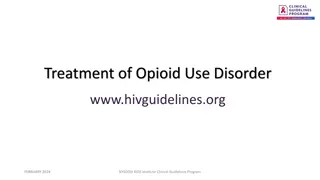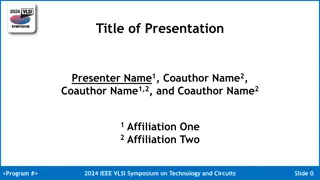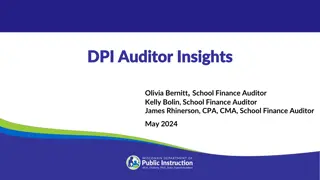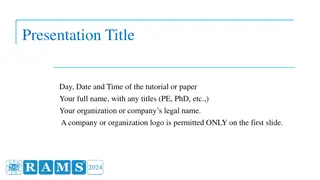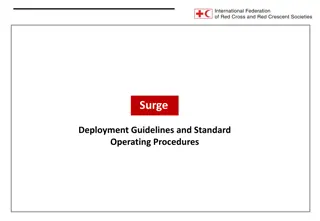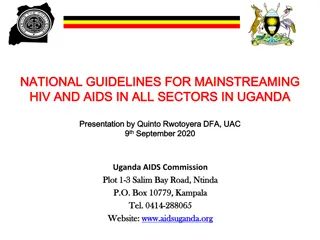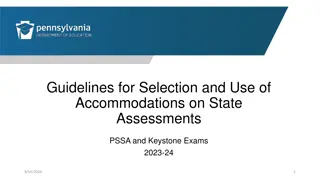
Effective IT Presentation Tips for Success
Discover essential guidelines for preparing and delivering a successful IT presentation, including tips on topic selection, time management, research, and preparation. Maximize your presentation potential with expert advice.
Download Presentation

Please find below an Image/Link to download the presentation.
The content on the website is provided AS IS for your information and personal use only. It may not be sold, licensed, or shared on other websites without obtaining consent from the author. If you encounter any issues during the download, it is possible that the publisher has removed the file from their server.
You are allowed to download the files provided on this website for personal or commercial use, subject to the condition that they are used lawfully. All files are the property of their respective owners.
The content on the website is provided AS IS for your information and personal use only. It may not be sold, licensed, or shared on other websites without obtaining consent from the author.
E N D
Presentation Transcript
General guidelines If you think you might have difficulty speaking in front of your group, let me know immediately. Sharing your concerns with your teacher does make a difference! Remember: this presentation a requirement for you to pass this course. There is no way around it. Since the exam is written, we consider the presentation as your oral exam (with max 6 points). Also remember that both your teacher and your classmates are on your side no need to be scared or worried!
How long should a presentation be? Your presentation has to be no less than 8 and no more than 10 minutes long. That said, you need to speak for at least 8 minutes. Speaking for e.g. 5 minutes and then showing a 3 minute video does not count. Remember you will probably speak more slowly while practicing at home than in the classroom. It is important to stick to the time limit (your timing will be measured and is a part of your grade)! If you overstep your 10 minutes time limit, the teacher has the right to stop you. If you finish earlier than 8 minutes, the teacher will encourage you to continue. Maximum time for Q&A is 5 minutes after your presentation!
What should I talk about? Your topic SHOULD BE IT-RELATED The most important thing is that you present something you are passionate about - a topic that interests you works much better in presentations than a topic that you have randomly chosen. If you still cannot find a topic of your interest in the IT field, you are allowed to chose an IT unrelated topic (although this is not preferred )
Topics Check these websites and select your topic: https://indiaclass.com/information-technology-presentation-topics/ https://indiaclass.com/computer-science-presentation-topics/ https://krazytech.com/technical-papers/latest-technical-paper-topics-for-presentation https://major-walter-nowotny.net/paper-presentation-it/ https://www.youtube.com/watch?v=-GgyZCcAj-A https://www.quora.com/What-are-some-interesting-and-funny-topics-for-a-presentation-in-an-ICT-class https://www.topicsforseminar.com/2022/01/technical-seminar-topics.html https://examfeed.com/information-technology-seminar-topics/
Do your research! I need to see you ve put some time and effort into your presentation. You cannot confidently present a topic without checking various resources and getting familiar with all relevant details. Think of yourself as a teacher your goal is to teach the class about a topic you know more than the audience. List your sources at the end of presentation!
Preparation Practice, practice, practice (in front of a mirror, family or friends or simply videotape yourself). Deliver presentation within determined time limit. Spend appropriate of amount time on introduction, body, and conclusion. Think of what questions listeners might ask in the Q&A session and prepare sample responses.
Structure! Structure! Structure! Consider the structure of your presentation. The key to a successful presentation is a good introduction and a clear overview of the topic. INTRODUCTION BODY (ORGANIZATION OF MAIN AND SUPPORTING POINTS) CONCLUSION *PRO TIP: Start with a BANG! and finish with a BANG!!!
Structure! Structure! Structure! INTRODUCTION Have a strong introduction that grabs your listeners attention. What s in it for them and why should they listen? Engage audience with attention-getter (e.g., ask a question, present surprising fact, tell a story, make connection). Establish need/rationale for the project. Introduce and provide a clear overview of the project and preview the presentation s thesis/main points.
Structure! Structure! Structure! BODY (ORGANIZATION OF MAIN AND SUPPORTING POINTS) Order logically and coherently main points and supporting points. Stay on topic and talk about one thing at a time. Demonstrate thorough knowledge of the literature or research related to project. Present relevant information. Support materials should be timely, appropriate, and credible.
Structure! Structure! Structure! CONCLUSION Transit clearly from body to conclusion. Summarize main points/thesis. Repeat significance, key takeaways, next steps, and/or recommendations as appropriate. Q&A: Invite questions at the end.
Presentation aids Limit the amount of text on each slide (use visuals and bullet points, not full sentences!). Use images/graphics/text that can be quickly interpreted. Legible, audible, and accessible (appropriate volume, text size, font, typeface, colors; audio should be captioned) Use a large font size (recommended - minimum 20, maximum 28). Images/graphics should be of good quality and appropriately cropped/placed. Correct, free of errors Style should be consistent throughout entire presentation. Aids should be seamlessly integrated.
Presentation aids Feel free to include short videos if they contribute to the overall presentation (but remember, they do not count towards the speaking minimum of 8 minutes). Use bullet points only (not full sentences). You may use high-quality images or graphics. You may want to show some websites. You may want to use the whiteboard to explain a point. BASICALLY, you need to decide which presentation aids are appropriate for your presentation.
Language Clear pronunciation and articulation Strong conversational quality (minimal reading, vary pitch, rate, volume, and intensity) Appropriate pace/rate (not rushed or drawn out) Avoid fillers such as um, like, you know. Use appropriate level of formality for the occasion. Jokes are a great ice-breaker, but remember your presentation should primarily be informative, not entertaining. Use simple words and grammatical structures if more complex words and structures are likely to give you trouble. Speak loud enough for everyone to hear you.
Body language NEVER show your back to your audience. Avoid doing anything that makes you look nervous (hand-wringing, slouching, rocking, swaying, fidgeting, looking at the floor). MAKE EYE CONTACT with individual people in different areas of the room (look at the tops of people's heads if you are nervous). Do not freeze and stand still but also do not pace around the classroom nervously! Stand up straight. Do a POWER POSE before the presentation! DON T FORGET TO SMILE! Check this http://www.businessenglishresources.com/31-2/student-section/student-handouts/ signposts-test/
2 obligatory slides to have INTRODUCTORY SLIDE with your name, date and the topic of your presentation FINAL SLIDE with the sources you have used Other slides are dependent on your topic however, overall number of slides should not exceed 15.
Can I use notes? Feel free to use written notes or cards to help yourself during the presentation, but do not just write down the whole presentation and read it out loud. That s a big NO NO! Please do not make notes on your mobile phone this is not professional! If you want to make notes within your PPT presentation, you can do so because there is a big TV screen only you will be able to see during the presentation.
Is the audience important? EYE CONTACT with the audience is extremely important. ENGAGING THE AUDIENCE you are not reciting a poem or reading a chapter from a book; you are explaining your topic to the audience and you should aim for ACTIVE AUDIENCE ENGAGEMENT ask them questions, include them in the follow-up questions DIRECTLY ADDRESS THE AUDIENCE! Think of yourself as a teacher and your audience as your students! This always works the best!
Bad vs. Good Presentation Watch this video and assess the presentations: How to Create a Presentation And Avoid Bad Design
Tips and Tricks Watch these videos on Expert Academy YouTube channel PUBLIC SPEAKING SKILLS: There you will find many useful tips and tricks for preparing and delivering your presentation, such as: How to start and end a presentation; Presentation body language; Overcoming public speech stress and anxiety; Storytelling tips for presentations...
For those who want more https://www.ted.com/talks/amy_cuddy_your_body_language_ma y_shape_who_you_are https://www.ted.com/talks/julian_treasure_how_to_speak_so_that _people_want_to_listen
Missing your time slot AGREED SCHEDULE is available on MS TEAMS. If you know you will miss your presentation time slot switch with a colleague and e-mail me ASAP. Simply not showing up without a notice results in MINUS 1 POINT (for the first time) and A FAIL (for the second time)! Of course, last minute situations do happen and I am fully aware of that contact me and we will find a solution!
Scoring Guide MAX POINTS 1 1 1 1 1 1 CRITERIA AND DESCRIPTORS KNOWLEDGE The student consistently demonstrates knowledge and understanding of the topic and answers audience questions with confidence and accuracy. STRUCTURE All ideas are presented in a clear, concise, coherent and structured manner. TIME Delivers presentation within determined time limit. PRESENTATION AIDS Correct, free of errors Style is consistent throughout entire presentation. Images/graphics/t ext can be quickly interpreted. Use of visual aids support the main ideas of the presentation and are of high quality, without any distracting factors. LANGUAGE The student uses language that is accurate and easy to understand. The language has appropriate level of formality. The pace of speech is appropriate not rushed or drawn out. The tone of voice is right not too loud and not too soft. The pronunciation and articulation are clear. BODY LANGUAGE The student uses positive body language (e.g. stance) and engages with the audience (e.g.makes eye contact). There are no distracting gestures. The students interacts with, but does not read from, presentation aids.










